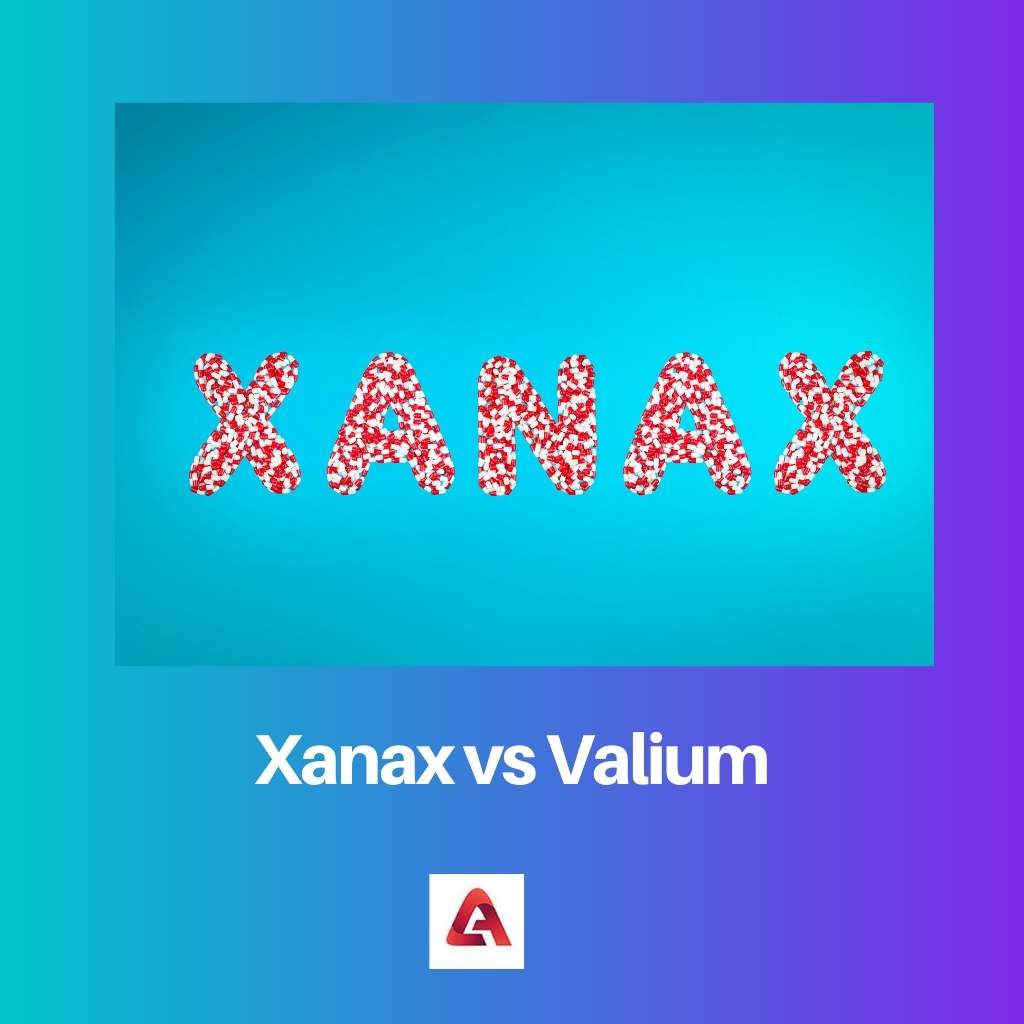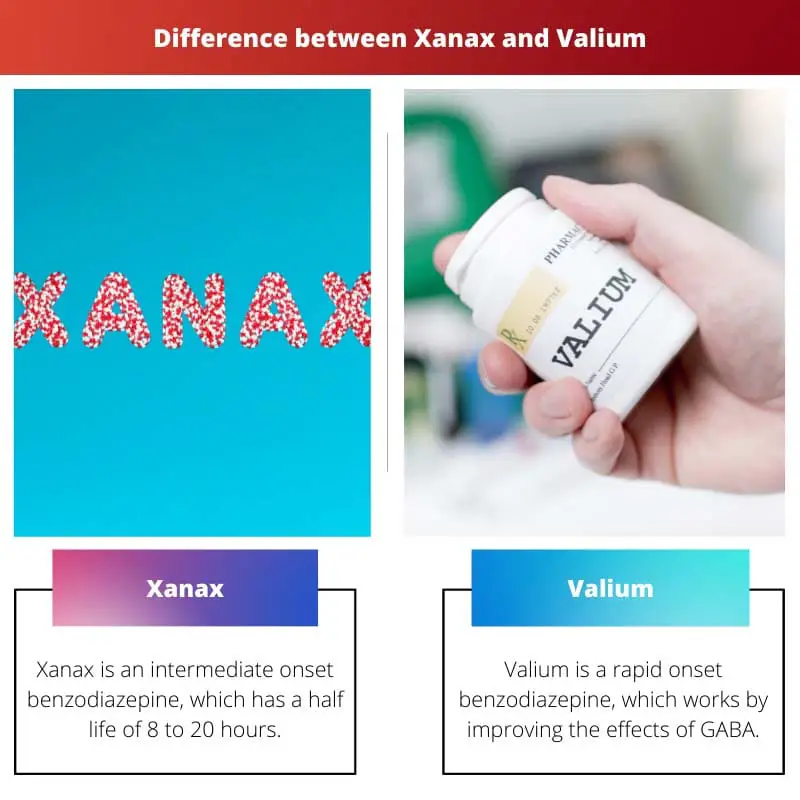Xanax and valium are two drugs that have a practical application to treat anxiety disorders. Both Xanax and Valium are minor tranquillizers. Although both drugs are similar, they are not exactly alike.
Xanax is an intermediate-onset benzodiazepine. It has a half-life of 8 to 20 hours. On the other hand, valium is a rapid-onset benzodiazepine, which works by improving the effects of GABA (gamma-aminobutyric acid).
Key Takeaways
- Xanax, or alprazolam, is a short-acting benzodiazepine, whereas Valium, or diazepam, is a long-acting benzodiazepine.
- Xanax is primarily prescribed for anxiety and panic disorders, while Valium is more commonly used for muscle relaxation and to treat seizures.
- Valium has a longer half-life than Xanax, which can lead to a higher potential for dependence and addiction.
Xanax vs Valium
The difference between Xanax and Valium is that the generic name of Xanax is alprazolam. On the other hand, the generic name of valium is diazepam. Xanax has practical use in the treatment of panic and anxiety disorders. In contrast, valium has practical use in the treatment of seizure disorders, muscle spasms, and anxiety.

Xanax is a member of the class of generic drugs called benzodiazepines. It is an intermediate-onset benzodiazepine, which has a half-life of 8 to 20 hours and has practical use in treating seizure disorders, muscle spasms, and anxiety.
Xanax has a slow reaction time and mobility. It may cause drowsiness and confusion. More severely, it can cause depression of the CNS ( Central Nervous System ) in the patient.
Valium is a generic drug that is a member of the class called benzodiazepines. It is a rapid-onset benzodiazepine which works by improving the effects of GABA (gamma-aminobutyric acid).
Valium has practical use in the treatment of seizure disorders, muscle spasms, and anxiety. Valium can likely cause confusion, drowsiness, and lightheadedness in the patient. More severely, it can cause depression in the CNS ( Central Nervous System ).
Comparison Table
| Parameters of Comparison | Xanax | Valium |
|---|---|---|
| Definition | Xanax is an intermediate onset benzodiazepine, which has a half life of 8 to 20 hours. | Valium is a rapid onset benzodiazepine, which works by improving the effects of GABA (gamma-aminobutyric acid). |
| Practical application | It has practical use in the treatment of panic and anxiety disorders. | It has a practical use in the treatment of seizure disorders, muscle spasms, and anxiety. |
| Generic name | The generic name of Xanax is alprazolam. | The generic name of valium is diazepam. |
| Available forms | The drug is available in concentrated oral solution, and tablets. | The drug is available in oral solution (concentrated and unconcentrated), tablets, rectal gel, and intravenous solution. |
| Standard Dosage | The standard dosage of Xanax varies from 0.25mg to 0.5 mg three times in a day. | The standard dosage of valium ranges from 2mg to 10mg two to four times in a day. |
| Side effects | Xanax has side effects such as changes in weight and constipation. | Valium has side effects such as ataxia, rash, euphoria, and diarrhoea. |
What is Xanax?
Xanax is a member of the class of generic drugs called benzodiazepines. It has practical use in the treatment of panic and anxiety disorders. Moreover, the use of Xanax needs medical evaluation by a physician and a prescription to procure.
It is an intermediate-onset benzodiazepine, which has a half-life of 8 to 20 hours. Xanax is a generic drug used to treat neutral conditions like anxiety. The generic name of Xanax is alprazolam. The drug is available in the form of concentrated oral solutions and tablets.
The standard dosage of Xanax varies from 0.25mg to 0.5 mg three times a day. The typical treatment of Xanax is short-term. In addition, it has a practical application in treating anxiety in children above seven years of age and adults.
Xanax has a slow reaction time and mobility. It may cause drowsiness and confusion. More severely, it can cause depression of the CNS ( Central Nervous System ) in the patient. Xanax is a D category at the time of pregnancy. In addition, it has the potential to cause abuse and dependence.
The consumption of Xanax shall take place under the strict supervision of the physician. It can cause harmful side effects in the elderly and patients with a high risk of falls. The drug shall be in use for a short period.

What is Valium?
Valium is a generic drug that is a member of the class called benzodiazepines. It has practical use in the treatment of seizure disorders, muscle spasms, and anxiety.
The use of valium needs medical evaluation by a physician and a prescription to procure. Valium is a rapid-onset benzodiazepine which works by improving the effects of GABA (gamma-aminobutyric acid).
The generic name of valium is diazepam. The drug is available in oral solution (concentrated and unconcentrated), tablets, rectal gel, and intravenous solution.
The standard dosage of valium ranges from 2mg to 10mg two to four times a day. The typical treatment of valium is short-term. However, the after-effects of valium take a long time to wear off completely.
Valium can likely cause confusion, constipation, drowsiness, nausea, and light-headedness in the patient. More severely, it can cause depression in the CNS ( Central Nervous System ).
In addition, it is a D-category drug at the time of pregnancy. During the intake of valium, patients are not allowed to consume grapefruit or grapefruit juice.
Valium can cause harmful side effects in the elderly and patients with a high risk of falls. Patients consuming the drug shall be in close contact with their physicians. Conclusively, Valium should be used for a short period to prevent any severe after-effects.

Main Differences Between Xanax and Valium
- The generic name of Xanax is alprazolam. On the other hand, the generic name of valium is diazepam.
- Xanax has practical use in the treatment of panic and anxiety disorders. In contrast, valium has practical use in the treatment of seizure disorders, muscle spasms, and anxiety.
- The dosage of Xanax varies from 0.25mg to 0.5 mg three times a day. However, the standard dosage of valium ranges from 2mg to 10mg two to four times a day.
- Xanax is available in the form of concentrated oral solutions and tablets. On the other hand, valium is available in oral solution (concentrated and unconcentrated), tablets, rectal gel, and intravenous solution.
- Xanax is an intermediate-onset benzodiazepine. It has a half-life of 8 to 20 hours. In contrast, valium is a rapid-onset benzodiazepine which works by improving the effects of GABA (gamma-aminobutyric acid).




